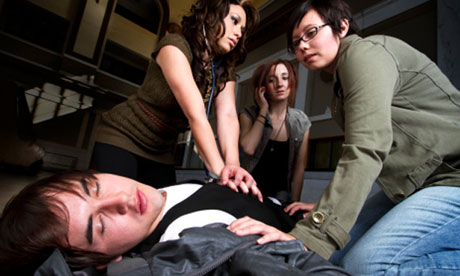CPR for 38 minutes or longer improves chance to survive cardiac arrest
Performing CPR for 38 minutes or longer can improve a patient’s chance of surviving cardiac arrest, according to a study presented at the American Heart Association’s Scientific Sessions 2013.
Sustaining CPR that long also improves the chances that survivors will have normal brain function, researchers said.
Cardiac arrest occurs when electrical impulses in the heart become rapid or chaotic, causing it to suddenly stop beating.
About 80 percent of cardiac arrests - nearly 288,000 people - occur outside of a hospital each year, and fewer than 10 percent survive, according to the American Heart Association.
Research has found that early return of spontaneous circulation - the body pumping blood on its own - is important for people to survive cardiac arrest with normal brain function. But little research has focused on the period between cardiac arrest and any return of spontaneous circulation.
Using a massive registry tracking all out-of-hospital cardiac arrests in Japan in 2005-11, researchers studied how much time passed between survivors’ collapse and the return of spontaneous circulation, and how well brain function was preserved a month later.
 Survivors were considered to have fared well neurologically if they were alert and able to return to normal activities, or if they had moderate disability but were well enough to work part-time in a sheltered environment or take part in daily activities independently.
Survivors were considered to have fared well neurologically if they were alert and able to return to normal activities, or if they had moderate disability but were well enough to work part-time in a sheltered environment or take part in daily activities independently.
The time between collapse and return of spontaneous circulation for those who fared well was 13 minutes compared to about 21 minutes for those who suffered severe brain disability, said Ken Nagao, M.D., Ph.D., professor and director-in-chief of the Department of Cardiology, CPR and Emergency Cardiovascular Care at Surugadai Nihon University Hospital in Tokyo.
After adjusting for other factors that can affect neurological outcomes, researchers found that the odds of surviving an out-of-hospital cardiac arrest without severe brain damage dropped 5 percent for every 60 seconds that passed before spontaneous circulation was restored.
Based on the relationship between favorable brain outcomes and the time from collapse to a return of spontaneous circulation, the researchers calculated that CPR lasting 38 minutes or more was advisable.
“It may be appropriate to continue CPR if the return of spontaneous circulation occurs for any period of time,” said Nagao.
The 2010 AHA Guidelines for CPR and ECC advise bystanders to perform CPR until emergency crews arrive.
The Japanese Circulation Society Resuscitation Science Study group conducted the study.
Co-authors are Eizo Tachibana, M.D., Ph.D.; Tukasa Yagi, M.D., Ph.D; Naohiro Yonemoto, Dr.P.H.; Morimasa Takayama, M.D., Ph.D.; Hiroshi Nogoni, M.D., Ph.D.; Shinichi Shirai, M.D., Ph.D.; and Takeshi Kimura, M.D., Ph.D. Author disclosures are on the abstract.
Note: Actual presentation is 5:15 p.m. CT/6:15 pm ET Saturday, Nov. 16, 2013.
For more information, see CPR facts and statistics.
For more news from AHA Scientific Sessions 2013 follow us on Twitter @HeartNews #AHA13.
###
Statements and conclusions of study authors that are presented at American Heart Association scientific meetings are solely those of the study authors and do not necessarily reflect association policy or position. The association makes no representation or warranty as to their accuracy or reliability. The association receives funding primarily from individuals; foundations and corporations (including pharmaceutical, device manufacturers and other companies) also make donations and fund specific association programs and events. The association has strict policies to prevent these relationships from influencing the science content.
For Media Inquiries:
AHA News Media in Dallas: (214) 706-1396
AHA News Media Office, Nov. 16-20
at the Dallas Convention Center: (214) 853-8008
For Public Inquiries: (800) AHA-USA1 (242-8721)
###